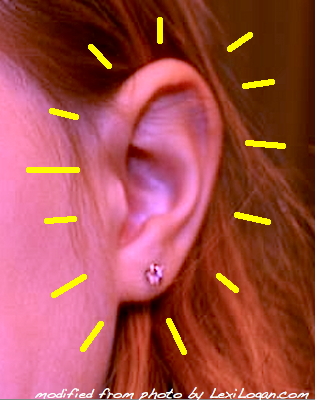Summertime ear pain? It might be swimmer’s ear

These lucky fish don’t have to worry about swimmer’s ear… they don’t have any ears! –Photo by Dirk Peterson, MD
It’s the type of ear pain that usually creeps up on a school-aged summer camper. One night he may notice discomfort when his ear is against his pillow. The next night, the pain gets worse. Eventually, even touching the ear is painful. The ear is probably infected, but infected with “the other kind” of ear infection—swimmer’s ear.
Ear infections are divided into two main types: swimmer’s ear (otitis externa) and middle ear infections (otitis media). An understanding of the anatomy of the ear is important to understanding the differences between the two types of infection. Imagine you are walking into someone’s ear. When you first enter, you will be in a long tunnel. Keep walking and you will be faced with a closed door. The tunnel is called the external ear canal and the door is called the ear drum.
Swimmer’s ear occurs in the ear canal. Dampness from water, and it can be water from any source- not just the pool, sits in the ear canal and promotes bacterial infection.
Next, open the door. You will find yourself in a room with a set of three bones. Another closed door lies at the far end. Look down. In the floor of the room there is an opening to a drainage pipe. This room is called the middle ear. This is where middle ear infections occur.
During a middle ear infection, fluid, such as during a cold, can collect in the room and promote bacterial infection. Think of the sensation of clogged ears when you have a cold. Usually the drainage pipe, called the eustachian tube, drains the fluid. But, if the drain is not working well, or is overwhelmed, fluid gets stuck in the middle ear and become infected.
Because a swimmer’s ear infection occurs in the external canal, the hallmark symptom of swimmer’s ear is pain produced by pulling the outside of the ear. Since middle ear infections occur farther down in the ear, pain is not reproduced by pulling on the outer ear.
Doctors treat swimmer’s ear topically with prescription antibiotic drops. To avoid dizziness and discomfort when putting drops in, first bring the ear drop medicine up to body temp by holding the bottle in your hand.
Home remedies to prevent swimmer’s ear:
- After immersion in the water, tilt your child’s head to the side and towel dry what leaks out.
- Mix rubbing alcohol and vinegar in equal parts. After swimming, place a couple drops in the ear. Do not put these drops in if there is a hole in your child’s eardrum.
- Prior to swimming put a drop of mineral oil or olive oil in each ear. This serves as a barrier protection against the water as well an ear wax softener. Do not put in if there is a hole in your child’s eardrum.
Although it’s tough to remind children to dry their ears well, take heart. Dr. Lai once spent two hours trying to get a cockroach out of a child’s ear canal. We suspect those parents would have been happier if instead, water had gotten into their child’s ear.
Naline Lai, MD and Julie Kardos, MD
©2017 Two Peds in a Pod®
updated from 2016
